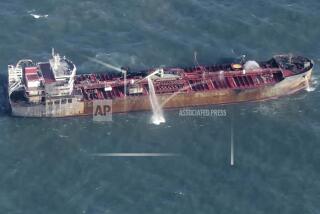Major Fuel Leak Stoked Carrier Blaze
- Share via
A major leak that oozed from a jet fuel line of the aircraft carrier Constellation into a boiler room was unofficially blamed Wednesday for a nine-hour blaze that injured 20 sailors. The huge ship returned to port.
Sailors who fought the conflagration said that at one time a fireball roared through the boiler room and onto the second deck of the carrier.
Rodger L. Laws, 33, a machinist mate first class who runs Boiler Room No. 1, where the fire broke out, was the first firefighter to enter the room after the initial explosion shortly before noon Tuesday.
Steam Pipes Were White-Hot
Laws saw “a major fuel leak” dripping onto the white-hot pipes that carry steam to the main engine. Within minutes, an explosion occurred. Two men standing nearby, Lt. Richard Gene Kidd and Chief Warrant Officer Victor Mark Delgado, were burned so badly on their hands that they required extensive plastic surgery, Laws said.
Forty-five minutes later, Laws re-entered the boiler room, where he spends most of his time. On Wednesday, he described a second, equally savage explosion. He said the room was engulfed with what appeared to be a huge--and seemingly inescapable--ball of fire.
“I’m a volunteer firefighter in Pennsylvania, where I’m from,” he said. “I’ve fought some pretty mean forest fires, but nothing like this. This was as bad as it gets on an aircraft carrier.”
He said the jet fuel was dripping onto pipes with a surface temperature of 975 degrees Fahrenheit. He said the first of several explosions sent a fireball hurtling onto the second deck of the carrier, which is more than 1,000 feet long.
Next to combat, Laws said, fires are the worst problem on a ship the size of the Constellation. The huge vessel was on a routine mission, scheduled to be at sea for “maybe a week,” Laws said.
But Wednesday, the ship returned to port early, and the official cause of the fire has yet to be determined by a Navy inquiry. Navy spokesman Lt. Cmdr. Bob Pritchard said “no one knows” when the inquiry might be finished or when the Constellation will sail again.
It returned to North Island Naval Air Station under its own power, accompanied by tugboats and helicopters, and was awaited by about 75 friends and relatives who had heard of the fire--most by watching the television news. No one knew for sure whether loved ones had been injured until about 6 a.m. Wednesday. Most spent a sleepless Tuesday night.
Shari Eytel, 26, the wife of one of the crew members, is one of five “Connie” wives acting as ombudsmen. Eytel said she fielded hundreds of calls from worried wives--a task she described as “a headache . . . an incredible nightmare.”
Eytel was introduced to the media by Pritchard, as were Laws and two other sailors. Laws and Master Chief Hull Technician Errol Person, 42, were two of the men most directly involved in fighting the fire, Pritchard said.
Person called the blaze “a worst-case scenario for what can happen on a carrier” and said every member of the 2,500-member crew had been involved in putting the fire out.
He described the timetable this way: The fuel leak occurred around 11:30, with the first blast shortly afterward. The sailors re-entered the boiler room about 45 minutes later. The second blast came about 2 p.m., and, finally, a third blast occurred after a final re-entry about 4 p.m. Person said several other explosions occurred but none was significant. The fire was extinguished about 9 p.m. Tuesday.
Airspace Restricted for a While
An “airspace reservation,” banning aircraft within a 5-mile radius and below 5,000 feet, was imposed by the Federal Aviation Administration and remained in effect until early Wednesday.
“The worst moment for me was that second explosion,” Person said. “I was standing at the front door (of the boiler room) and saw the fireball coming right at me. Right then, I thought of my three children. I just prayed they were OK.”
Laws said he knew his wife and children would be nervous and upset, but he worried more about Kidd and Delgado, “who were standing right there” at the time of the first explosion. “Both took a pretty good hit,” he said.
Navy spokesmen said the Constellation completed a 13-month, $235-million overhaul in 1984, but they acknowledged it had suffered several accidents, including other fires. Laws and Person were terse, if not defensive, about the safety and reputation of the ship. Both defended the “integrity of the vessel”--Laws’ phrase, as well as the sailors who fought the fire.
Called Intense by Crewman
Person described the blaze as “unusual in its intensity,” saying, “I just never saw anything like it.”
He said the crew waited after the first explosion, “then re-entered the space, only to have it flash again. It flashed again a third time and was pretty active that time, too, but finally it started to calm down.”
Laws said the scariest moment for him was “having to go back in there (after the first explosion). It was maybe 175 degrees in there. The hair on my legs started to burn.
“You feel trapped. There ain’t no place to go on a ship when a fire breaks out. You got the water, but I don’t swim that well. I sure didn’t want to swim that far.”
More to Read
Sign up for Essential California
The most important California stories and recommendations in your inbox every morning.
You may occasionally receive promotional content from the Los Angeles Times.












